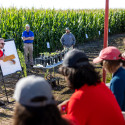Falling milk prices cause tough 2006 for Wisconsin farmers, report says
Overall, 2006 was a tough year for Wisconsin farmers. The state’s total net farm income dropped by more than 40 percent, the lowest level since 2002.
Not all farmers suffered equally. The year ended well for corn and soybean farmers. Returns for most livestock were so-so, but turkey and egg producers did fine. Yields and prices for the state’s diverse vegetable and fruit sector varied from crop to crop.
But a larger-than-expected downturn in prices for milk — source of more than half of the state’s farm receipts — weighed heavily on Wisconsin’s farm economy, point out University of Wisconsin–Madison agricultural economists in their annual Status of Wisconsin Agriculture report.
A year ago, industry analysts — including those at UW–Madison — were predicting that the state’s average all-milk price would drop by about 8 percent from 2005 levels. In fact, it dropped about 15 percent, from $14.50 per hundredweight to $11.90 per hundredweight.
Still, 2006 also brought Wisconsin’s dairy industry one piece of good news: After years of decline, the size of the state’s cow herd increased. Wisconsin milk cow numbers have been decreasing every year since 1986, except for a 1,000-cow increase in 1990. But the average number of cows in the state herd in 2006 exceeded that of 2005 by 7,000 head.
“We have finally stopped the bloodletting in cow numbers,” says dairy marketing and policy specialist Ed Jesse, editor of the UW–Madison report.
“Between 1985 and 2001, Wisconsin was losing more than 35,000 dairy cows per year,” Jesse adds. “In March of 2005, we hit a low of 1.23 million, and cow numbers have been growing since then. In December of 2006 we had 1.25 million head.
“While we’re going to continue to see a loss in dairy herds, I think that consolidation into larger herds will maintain or slowly grow cow numbers. We’re not like New Mexico or West Texas — we’re not going to add 20 or 30,000 cows a year. We are building Wisconsin’s herd, but slowly.”
Among other comments in the report:
— Milk prices will rebound in 2007. The report’s authors predict an increase in the all-milk price in the range of $.90-$1.65 per hundredweight. But gains in dairy profits will be limited by higher costs. Corn will be costlier. So will hay, due to a short crop last year and heavier feeding of hay in drought areas.
— Dairy product consumption is expected to increase by about 1.7 percent — the average increase in recent years — but could be lower if a spike in oil prices tightens consumers’ budgets.
— Wisconsin milk production increased for the second year in a row — it rose 3.5 percent in 2005 and by an estimated 2 percent in 2006. Total production in 2006 was 23.3 billion pounds, still below the state’s production peak of 25 billion pounds in 1988.
— The drop in milk prices was caused by a 2.7 percent increase in the U.S. milk supply that outstripped a 2 percent increase in commercial use. The boost in production came because farmers were milking more cows (encouraged by good prices the year before) and because of a 4 percent increase in milk yield — about double the average annual yield increase during the past 10 years.
— Corn and soybean markets both rallied by more than $1 per bushel at the end of the year, spurred by market speculation and demand from ethanol plants. USDA expects ethanol to absorb 20 percent of the 2006 corn crop. The market for corn will likely continue strong in 2007, but despite the nation’s thirst for ethanol, opinions vary as to whether the corn boom will sustain itself over the long haul.
— Wisconsin farm production costs were up in 2006, but the year-over-year increase was smaller than in 2005. Purchased inputs cost about 6 percent more, much of that increase coming from higher fertilizer and fuel prices. Interest expenses climbed almost 9 percent.
— Wisconsin potato acreage dropped about 3 percent in 2006, but yields were up 6 percent. A larger U.S. crop will pull 2006 prices down a bit from 2005. U.S. potato growers have been able to recover from a 2002-04 price slump by working together to curb supply to create higher prices in the face of stable demand.
The Status of Wisconsin Agriculture is authored by agricultural economists and other commodity specialists at UW–Madison. It includes reports on dairy, livestock and poultry, fruits and vegetables, farm inputs and the general economy. It also contains two special reports: One looks at opportunities and challenges related to biofuels; the other discusses how budget constraints and the change in Congressional leadership will affect the 2007 farm bill.
The report is available at no cost. Copies can be requested from Linda Davis, UW–Madison Department of Agricultural and Applied Economics, 427 Lorch St., Madison, WI 53706.
Tags: business




